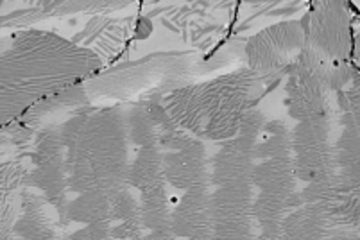All genres
21.
Journal Article
On the importance of a connected hard-phase skeleton for the creep resistance of Mg alloys. Acta Materialia 60, pp. 2277 - 2289 (2012)
22.
Journal Article
Orientation dependence of shear banding in face-centered-cubic single crystals. Acta Materialia 60, pp. 3415 - 3434 (2012)
23.
Journal Article
An elasto-viscoplastic formulation based on fast Fourier transforms for the prediction of micromechanical fields in polycrystalline materials. International Journal of Plasticity 32-33, pp. 59 - 69 (2012)
24.
Journal Article
Simulation of dislocation penetration through a general low-angle grain boundary. Acta Materialia 60, pp. 5380 - 5390 (2012)
25.
Journal Article
Characterization and Modeling of Heterogeneous Deformation in Commercial Purity Titanium. Journal of Microscopy 63 (9), pp. 66 - 73 (2011)
26.
Journal Article
A dislocation density-based crystal plasticity constitutive model for prismatic slip in α-titanium. Acta Materialia 59, 18, pp. 7003 - 7009 (2011)
27.
Journal Article
Structure Evolution and Deformation Resistance in Production and Application of Ultrafine-grained Materials -- the Concept of Steady-state Grains. Materials Science Forum 683, pp. 163 - 181 (2011)
28.
Journal Article
Dislocation interactions and low-angle grain boundary strengthening. Acta Materialia 59, pp. 7125 - 7134 (2011)
29.
Journal Article
Control of dynamic recovery and strength by subgrain boundaries - Insights from stress-change tests on CaF2 single crystals. Philosophical Magazine A 91 (6), pp. 908 - 931 (2011)
30.
Journal Article
Experimental Characterization and Crystal Plasticity Modeling of Heterogeneous Deformation in Polycrystalline α-Ti. Metallurgical and Materials Transactions A 42 (3), pp. 626 - 635 (2011)
31.
Journal Article
Quantitative Atomic Force Microscopy Characterization and Crystal Plasticity Finite Element Modeling of Heterogeneous Deformation in Commercial Purity Titanium. Metallurgical and Materials Transactions A 42 (3), pp. 636 - 644 (2011)
32.
Journal Article
Overview of constitutive laws, kinematics, homogenization and multiscale methods in crystal plasticity finite-element modeling: Theory, experiments, applications. Acta Materialia 58 (4), pp. 1152 - 1211 (2010)
33.
Journal Article
Influence of microstructure on creep strength of MRI 230D Mg alloy. Journal of Physics: Conference Series 240 (1), 012068, pp. 01268-1 - 01268-4 (2010)
34.
Journal Article
A simple dislocation model of the influence of high-angle boundaries on the deformation behavior of ultrafine-grained materials. Journal of Physics: Conference Series 240 (1), 012136, pp. 012136-1 - 012136-4 (2010)
35.
Journal Article
Comparison of finite element and fast Fourier transform crystal plasticity solvers for texture prediction. Modelling and Simulation in Materials Science and Engineering 18 (8), 085005, pp. 085005-1 - 085005-21 (2010)
36.
Journal Article
A novel grain cluster-based homogenization scheme. Modelling and Simulation in Materials Science and Engineering 18 (1), 015006, pp. 015006-1 - 015006-21 (2010)
37.
Journal Article
Nucleation of paired twins at grain boundaries in titanium. Scripta Materialia 63, pp. 827 - 830 (2010)
38.
Journal Article
Twin Nucleation by Slip Transfer across Grain Boundaries in Commercial Purity Titanium. Metallurgical and Materials Transactions A 41 (2), pp. 421 - 430 (2010)
39.
Journal Article
Evolution of dislocation structure and deformation resistance in creep exemplified on single crystals of CaF2. Materials Science and Engineering A 510-511, pp. 46 - 50 (2009)
40.
Journal Article
Microstructural evolution during creep of Ca-containing AZ91. Materials Science and Engineering A 510-511, pp. 398 - 402 (2009)











